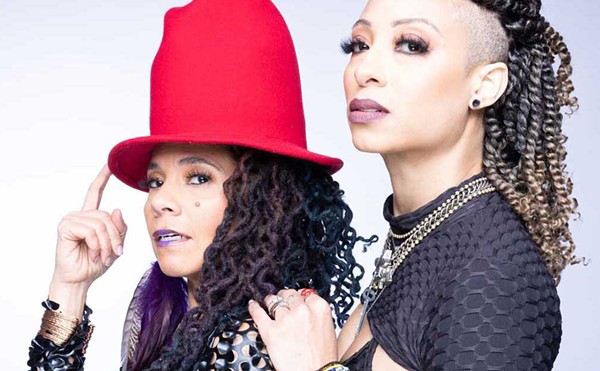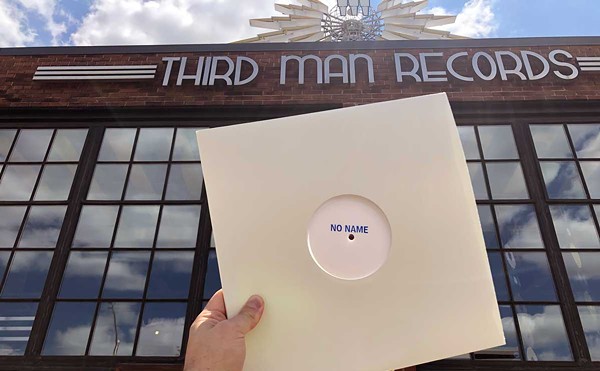Everyone knows that electronic music jargon is blatantly ridiculous and impossible to understand. Admit it, we all have to pretend to know what the next big thing is talking about when we hear, “I thought that knarzy rockno was the deepest shit when I heard it last November, but now it sounds just like IDM from ’99 played at 120 BPMs.”
What’s that shit really mean, you ask? Well, here’s the translation: “That German stuff that sounded so good last year now sounds like old progressive rock played too fast.”
Part of the reason for this glossary is to demystify and clarify some of the insidery language of electronica. A few definitions are obvious and quite literal, while others are, well, totally fucked up. But that’s part of the fun. Remember, this is a “music culture” meant to be experienced and not necessarily understood. So chill and enjoy this alphabetized glossary that any beat-soused musical tourist or burb-dwelling, beer-slurping sports fan can use. Just clip out and save.
Abstract: Music that contains layers of sounds and beats so erratic that shaking ass cheeks to it might be impossible. But you can try. This is an umbrella term under which a number of different styles (see “ambient,” “broken beat” and “IDM” below) can be contained.
Acid: A complex word that’s rooted in layers of slang. In terms of dance culture, it began not with LSD research studies in the 1950s and Timothy Learyisms of the 1960s, but with a way that club-dazed Brits needed to define the far-out sounds of Chicago in the mid-’80s. In short: Acid was the sound of suburban American rave culture in the early 1990s.
Ambient:Music with no beats or minimal beats. Gigantic whooshes of sound or practically no sound at all. Perfect music as a backdrop for thinking, feeling, schtupping, spliffing, reading or doing nothing.
Bass: In Detroit, bass historically refers to the music created by ’80s Miami-based stars like 2 Live Crew, who provided the woofer-destroying building blocks (and, you’ll note, fetching derriere imagery) for Detroit’s street-friendly dance scene. People new to the sonic energy of electronic dance music are often put off by the crunchiness and distortion of the bass. Either you wrap your mind and your ass around it, or you don’t.
Booty: Also known as ghetto-tech or ghetto-funk. A Detroit invention that combines elements of house, techno, bass, hip hop and electro with glorious strip club inelegance. A musical genre keen-eyed on asses of Detroit women. Pure, politically incorrect joy that the Dutch, French and Germans have a better intuition for than most uptight Americans.
Broken beat: It’s simple: Imagine hip-hop beats falling down stairs. It’s been the sound of Detroit’s Woodbridge neighborhood for the last five years.
BPM: Beats Per Minute. Also: how fast your heart races when you’re slamming on the dance floor.
DEMF: Detroit Electronic Music Festival, 2000-2002. The name of the festival for the first three years under the direction of Carol Marvin and (for the first two years) artistic director Carl Craig. The third year, though mired in scene drama, was planned by a strong committee of longtime Detroit producers and DJs.
Disco: When you hear this often-maligned genre during the festival, it won’t be the Bee Gees. It’ll more likely be a track like “You Make Me Feel (Mighty Real)” from the late black transvestite vocalist Sylvester, or extended jams by Motown’s Ashford and Simpson. It’s stuff that really made the “disco sucks” rock fascists nervous.
DJ: The disc jockey as selector, the person who chooses what record comes next, and sets the emotional temperature of the club space. DJs are, for better or for worse, the kings and queens of the scene.
Downtempo: Slowing the music down to normal breathing levels. Sexier than dancing to head-hammering techno. Chilling it down without getting all ambient.
Drum ’n’ bass:Like the sound of a roaring freight train, often with what appears to be chaotic snare and bass drum programming and sampled or live vocals. Fans of D ’n’ B are devoted, and spread out all over the planet. Large scenes still flourish in parts of the United States and Europe.
East Grand: As in The Boulevard. Home to the world’s most famed techno emporium, Submerge Records.
East Side: Roughly, Detroit east of Woodward Avenue. Home of the rave-converted Packard Plant and seemingly every other abandoned factory in Detroit. Musically, the East Side is considered to be the home of electro lovers (see below). No, we’re not talking Clinton Township or Lakeside Mall here.
Electro: The itchy, twitchy electrical outlet of dance music, filled with sounds pioneered in the early ’80s by such groups as Kraftwerk and Cybotron. A versatile style: Depeche Mode, the Pet Shop Boys and the Human League are electro; so are Detroit’s Adult., Ectomorph and booty DJs like Assault and Godfather.
Fuse-In: Part metaphor, part contractual obligation, the name merely extends the six-year melodrama more commonly known as “The Festival.”
Hip hop: At the beginning of Detroit’s techno culture in the early ’80s, hip hop was just one sound among many (electro, progressive, funk, disco, new wave) that could be used to turn a party out. Twenty years later, the difference in the various speeds of the styles and differences of culture may seem too significant to overcome. But just watch the Fuse-In crowd find common ground when Mos Def hits the stage.
House: The sound of Chicago, the heartbeat of New York, the call of the urban diva: a clear influence on Detroit techno and variations on electronic dance music developed in Europe. House is an outgrowth of disco; you can hear the syncopated beats and gorgeous melodic structures nurtured in the 1970s in almost every track. And its variation, deep house: House music built on smoother, rounder melodic tones and a less frenetic pace than its source.
IDM: Intelligent Dance Music. Rarely on the beat and less pop than the sounds your refrigerator makes, IDM is the elitist cousin of techno that makes for difficult dancing but far easier chin scratching.
Ital-Disco: A combination of acid house, techno and electro developed in Italy 25 years ago, and for years a part of DJ sets by Derrick May, Carl Craig and Stacey Pullen.
Jefferson Avenue: The street to bang on in the summer on the way to Belle Isle. The corner of East Grand Boulevard and Jefferson was the site of the, er, fuse that lit the 1943 riots, but now is home to a Starbucks financed by Magic Johnson. Mythologized by DJ Assault as the nasty-ass strip where you go to see “ass ’n’ titties” bounce.
Knarz: Crazy, Germanized techno that improbably combines elements of rock music and the baroque. The sound is dark and druggy, and works best in the basement of a factory between 4 a.m. and sunrise. Best practitioner scheduled for Fuse-In: Berliner Peter Grummich (who also records for Ann Arbor’s Spectral Sounds).
Minimal: Stripping dance music down to bare essentials. It could be house or techno played fast or slow, intended for the club or for listening on headphones. See UK-based Web site ubercoolische.com for a cheeky soap opera starring main practitioners Richie Hawtin, Magda and Ricardo Villalobos.
Movement: The name of the festival for years four and five, run by Derrick May and his Transmat record label. Though powerful and exciting at times, the most lasting image is of May tooling around in a golf cart with a bucket begging for money.
MusicoLogical: The name of Kevin Saunderson’s new production company. He says it’s a combination of reason and sound. We say, as we’re sure you do, “Huh?”
Producer: Another name for an artist who makes music, producing tracks with analog equipment or digitally with computer software. Not all producers of electronic music are DJs and many DJs are not producers. Both producers and DJs rarely play “live” (that is, create new music as they’re performing) thereby making many of Fuse-In’s live acts special enough not to be missed.
Rockno: A combo style that fuses rock, techno, electro and other influences. Who does it? See Pan/Tone, who is not on the festival lineup but will play one of the many afterparties (see afterparty rundown, online only at www.metrotimes.com).
Tha D: Detroit, Big D, Motown, The Motor City, Techno City, Technopolis. Got it?
The shit: An ear-bending musical experience so unimpeachable that true descriptive words escape you.
Techno: Beats played in 4/4 time. Melodies that sound like they were created in outer space. The music can come in wildly different variations, and be remixed into infinity. The sound that the entire world associates with Detroit.
Trance: The sound most reviled and snubbed by Detroit techno purists. It’s considered too commercial and far too stylized for many hardcore technophiles. But the sound is creeping into European techno and house records, and goddamn if it doesn’t sound good when used for escapist purposes. The Brits and Germans are calling this development acid-trance or neo-trance.
West side: Detroit’s neighborhoods west of Woodward. Home of Buy-Rite records and all of those boojie blacks who “invented” techno. Not Canton Township or Novi. No way, mister.
Read more:
Afterglow
Fuse-In satellite parties: A dozen reasons (plus three) to shun sleep all weekend.
The Detroit legends
The locals who put Detroit on the electronic music map.
The intercontinentalists
A glimpse of Fuse-In international must-sees.
State of grace
Globe-trotting homebody Kevin Saunderson on fame, family and the Fuse-In festival.
By the beat
Quick hit Q&A profiles of Fuse-In attractions.
For information on Detroit artists mentioned, visit www.metrotimes.com/guide/musicians.
Send comments to [email protected].




